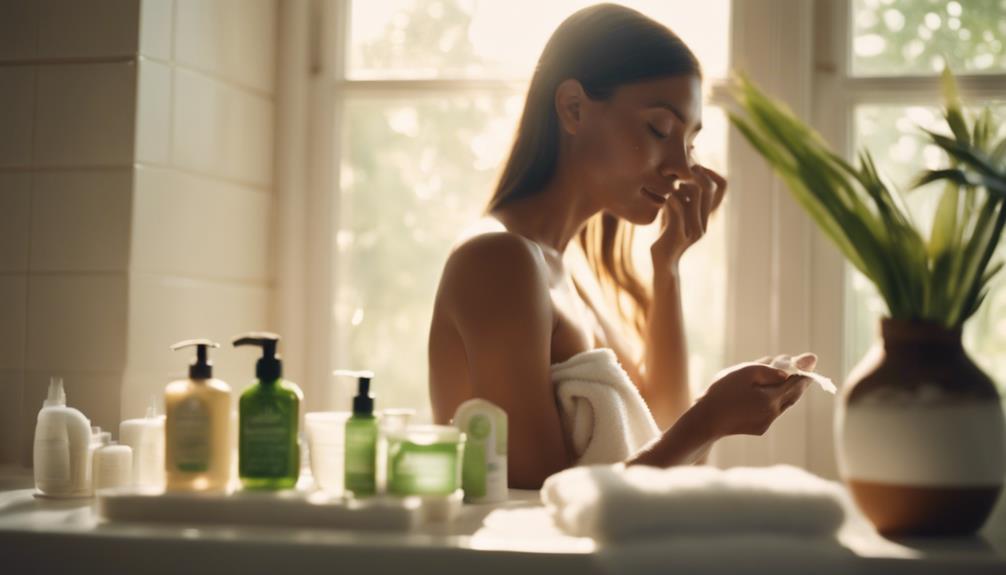To tan safely, it’s important to understand your skin type and set boundaries on how much exposure you get. If you have fair skin, start with short sessions of 1-3 minutes, while those with darker skin can go for 4-10 minutes. When using a tanning bed, beginners should start with Level 1 for a more gentle experience. Pay attention to your skin’s reaction and stop if you notice redness. Keep your skin hydrated, avoid wearing makeup before tanning, and always use protective eyewear. Knowing the signs of overexposure is crucial for the health of your skin. If you’re looking for more tips on achieving the perfect tan, click here.
Key Takeaways
- Determine your skin type to establish safe tanning session lengths and frequencies.
- Start with short sessions to gradually build your tan and prevent burns.
- Monitor your skin's response; stop tanning if you experience redness or tenderness.
- Use protective eyewear and moisturize before and after tanning to maintain skin health.
Understanding Your Skin Type
Understanding your skin type is crucial for safe tanning, as it determines how your skin reacts to UV exposure and guides your session duration.
Skin types range from Type 1, which is delicate and burns easily, to Type 5, which is more resilient and can tolerate longer sessions.
If you're a Type 1, start with sessions of just 1-3 minutes to avoid burns. In contrast, Type 5 can handle 4-10 minutes.
Always begin with brief sessions to introduce your skin to UV rays, and gradually increase exposure time while closely monitoring how your skin responds.
Adjusting your session length based on sensitivity is essential for maintaining skin health and preventing damage.
Choosing the Right Tanning Bed
Choosing the right tanning bed can greatly impact your tanning experience and skin health.
First, assess your skin type to determine the appropriate bed level. If you're a beginner, opt for a Level 1 bed, which offers gentle UVA/UVB exposure. As you gain experience, you might consider moving to Level 2 or Level 3 for deeper color.
Always pay attention to the UV output; higher levels mean shorter session times. Make certain the salon maintains their equipment properly for peak safety.
Don't forget to check if the tanning bed has features like facial tanners or adjustable settings for a customized experience.
Safe Tanning Frequency

Establishing a safe tanning frequency is essential for protecting your skin while achieving that desired glow.
Start by considering your skin type; if you have fair skin, limit your sessions to 1-3 minutes and space them out to allow your skin to recover.
For medium skin types, aim for sessions of 4-6 minutes, two to three times a week.
Darker skin can handle longer sessions, but moderation is still key.
Always pay attention to how your skin responds after each session. If you notice any redness or tenderness, take a break.
Essential Safety Precautions
What steps can you take to guarantee a safe tanning experience?
First, know your skin type and choose the right tanning bed for your needs.
Here are some essential safety precautions to follow:
- Start with short sessions to gradually build your tan and prevent burns.
- Stay hydrated and apply moisturizer before and after tanning to keep your skin healthy.
- Avoid makeup and exfoliate your skin beforehand for an even tan.
Post-Tanning Skincare Routine

After tanning, it's crucial to hydrate your skin and apply soothing products to maintain its health and enhance your glow.
Start by using a rich moisturizer or aloe vera to lock in moisture and calm any irritation. This helps to prevent dryness and keeps your tan looking vibrant.
Avoid hot showers or baths for at least 24 hours, as they can strip your skin of moisture. Instead, opt for lukewarm water and mild, hydrating cleansers.
Wear loose, breathable clothing to avoid friction on your skin.
Gently exfoliate a few days later to keep your tan even and fresh.
Signs of Overexposure
Recognizing the signs of overexposure is vital to protect your skin and guarantee a safe tanning experience. If you notice any of the following symptoms, it's imperative to stop tanning immediately:
- Skin redness or tenderness
- Peeling or blistering
- Dizziness or nausea
These signs indicate that your skin has had enough UV exposure, and pushing through can lead to serious damage.
Remember, there's no one-size-fits-all limit for tanning; it varies based on your skin type and the intensity of the tanning bed.
Always consult professionals for personalized advice and prioritize your skin health above achieving a tan.
Stay vigilant to guarantee your tanning journey remains enjoyable and safe!
Exploring Alternative Tanning Options

Many people increasingly seek alternative tanning options to achieve a sun-kissed glow without the risks associated with UV exposure.
Self-tanners are a popular choice, offering a range of products from lotions to sprays that can provide a natural-looking tan. These products contain dihydroxyacetone (DHA), which reacts with your skin to create color.
For a quicker option, consider bronzers or tinted moisturizers, giving instant color without commitment.
Another safe alternative is spray tanning at salons, where professionals apply an even coat for you.
Remember to exfoliate before any tanning method to guarantee a smooth application.
Always patch-test new products to avoid reactions, and enjoy your glow without the sun's harmful rays!
Is Tanning Safely Still Possible If It Doesn’t Burn Calories?
While tanning can be a relaxing activity, it’s important to remember the myth of calorie burning. Tanning does not burn a significant amount of calories. It’s still possible to tan safely without relying on it as a method of burning calories. Always prioritize skin safety and sunscreen use.
Conclusion
In your journey to achieve that perfect tan, remember that moderation is key.
Many believe that more tanning means a better glow, but the truth is, overexposure can lead to painful burns and long-term skin damage.
By understanding your skin type and following safe tanning practices, you can enjoy a beautiful, sun-kissed appearance without sacrificing your skin's health.
Embrace patience and knowledge; they're your best allies in tanning safely and effectively.
Your skin will thank you!










